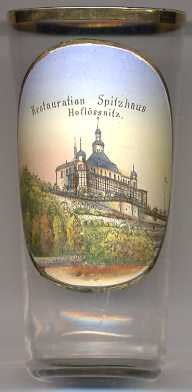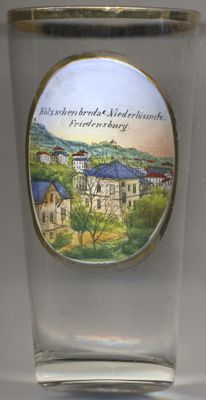

|
| DEUTSCHLAND | GERMANY |
| Bundesland: Freistaat Sachsen | Saxony |
| Landkreis: Meißen |
Radebeul is situated at an elevation of 117 m in the Elbe valley, just downstream of Dresden. It is well known for its viticulture, a museum dedicated to writer Karl May and a narrow gauge railway connecting Radebeul with the castle of Moritzburg and the town of Radeburg. The Meißen area, where Radebeul is located, is one of the northeasternmost areas where wine is grown today. The municipality of Radebeul has a population of about 33,300 (2012) and also comprises the former communities of Lindenau, Naundaorf, Oberlößnitz, Serkowitz, Wahnsdorf, Zitzschewig, Kötzschenbroda, Niederlößnitz, and Fürstenhain.
Radebůl was first mentioned in a written document in 1349. Other parts of today's municipality were mentioned first in 1144 (Naundorf), 1226 (Kötzschenbroda), 1287 (Lindenau), 1315 (Serkowitz), 1350 (Wahnsdorf), 1366 (Zitzschewig) and 1533 (Fürstenhain). In 1905 it absorbed the neighbouring village of Serkowitz. On 1 April 1924 Radebeul became a town. Meanwhile, the neighbouring village of Kötzschenbroda had taken over Lindenau in 1920 and Naundorf, Zitzschewig und Niederlößnitz by 1924, when it was made a town as well. In 1934 Wahnsdorf and Oberlößnitz joined Radebeul, and on 1 January 1935 the towns of Kötzschenbroda and Radebeul were united under the name of Radebeul. In 1947 Radebeul was made part of the district of Dresden. In 1995 it received the status of a major town inside the rural district (große Kreisstadt); when the rural district of Dresden (Dresden-Land) was dissolved, Radebeul became part of the district of Meißen.

Oberlößnitz today is a district of the municipality of Radebeul. From the 10th to the 12th century, German farmers from Main and Rhine Franconia, Thuringia and Lower Saxony were settled here by the landlords, the margraves and bishops, with the previous Sorbian residents being absorbed into the new German settlers. The margraves and bishops promoted viticulture, which is why the farmers cleared many slopes and created vineyard terraces. From the end of the 16th to the beginning of the 19th century, a number of manor houses were built that served as summer residences for the vineyard owners. A first communityl-like entity was created in 1838. Since 1839 Oberlößnitz was an independent municipality. On 1 April 1934, Oberlößnitz, together with neighboring Wahnsdorf, was incorporated into Radebeul.
The  Spitzhaus [left] is situated high on a hill above the Elbe valley in Radebeul's district of Oberlößnitz, above Hoflößnitz,
a former country estate of the Wettin dynasty. The core of the building was created in 1622 in late Renaissance style for Elector Johann Georg I of Saxony.
Its original name, due to its location, had been Hohes Haus ('high house'). Already in the 17th century the building and the surrounding vineyards changed into private hands.
Countess Constantia von Kosel obtained it in 1706 and in 1710 handed it over to her benefactor Friedrich August I of Saxony (August II 'The Strong' as King of Poland).
His son, Elector Friedrich August II (August III of Poland), ordered a major enlargement of the building in 1749 in Baroque style. The architect was Matthäus Daniel Pöppelmann.
Guests of the pavillion included Holy Roman Emperor Joseph II, King Charles X of France, King Otto I of Greece, or the Prussian Crown Prince Wilhelm (later German
King Wilhelm I of Prussia and first German Emperor). The Saxon Royal Court sold off the estate in 1888/89. In 1901/02 the two side wings were added in order to increase
the capacity of the building which in the meantime had become a popular country inn.
Spitzhaus [left] is situated high on a hill above the Elbe valley in Radebeul's district of Oberlößnitz, above Hoflößnitz,
a former country estate of the Wettin dynasty. The core of the building was created in 1622 in late Renaissance style for Elector Johann Georg I of Saxony.
Its original name, due to its location, had been Hohes Haus ('high house'). Already in the 17th century the building and the surrounding vineyards changed into private hands.
Countess Constantia von Kosel obtained it in 1706 and in 1710 handed it over to her benefactor Friedrich August I of Saxony (August II 'The Strong' as King of Poland).
His son, Elector Friedrich August II (August III of Poland), ordered a major enlargement of the building in 1749 in Baroque style. The architect was Matthäus Daniel Pöppelmann.
Guests of the pavillion included Holy Roman Emperor Joseph II, King Charles X of France, King Otto I of Greece, or the Prussian Crown Prince Wilhelm (later German
King Wilhelm I of Prussia and first German Emperor). The Saxon Royal Court sold off the estate in 1888/89. In 1901/02 the two side wings were added in order to increase
the capacity of the building which in the meantime had become a popular country inn.

Kötzschenbroda
is another district of the city of Radebeul. Kötzschenbroda consists of two parts of the area, since the founding of
Niederlößnitz on the vineyard area of Köötzschenbroda separated the upper area of the community as Kötzschenbroda Oberort from the lower area with
the village center. Following the Reunification of Germany in 1989, Köschenbroda and Niederlößnitz were merged into the unified city district (Gemarkung)
Kötzschenbroda.
Niederlößnitz
was first mentioned in written documents around 1271 in documents refering to the vineyards of Kötzschenbroda. The municipality
of Nieder-Lößnitz, separate from Kötzschenbroda, was founded in 1839. In 1923 Niederlößnitz was merged with K&ounl;tzschenbroda. In 1935, it
was merged into the municipality of Radebeul.
Glass no. 4484 [near left] is labeled Kötzschenbroda – Niederlössnitz / Friedensburg, which is somewhat strange, since the Friedensburg actually is not depicted on the glass. Only the tiny trace of a building in the top left edge of the image might be identified as a part of it.
The  Friedensburg [the tiny trace of a building at the top left edge corner of the image] was built in 1870/1871 as a
representative mountain inn in Historistic neo-Gothic style. Since 1895 it also operated as a hotel and became a popular tourist destination. The restaurant was closed
in 1993. Renovations were carried out in 1999/2000. Since then, the municipality of Radebeul and private investors have been arguing over the use of the building.
Friedensburg [the tiny trace of a building at the top left edge corner of the image] was built in 1870/1871 as a
representative mountain inn in Historistic neo-Gothic style. Since 1895 it also operated as a hotel and became a popular tourist destination. The restaurant was closed
in 1993. Renovations were carried out in 1999/2000. Since then, the municipality of Radebeul and private investors have been arguing over the use of the building.
[https://de.wikipedia.org/wiki/Radebeul, https://en.wikipedia.org/wiki/Radebeul;
https://de.wikipedia.org/wiki/Oberl%C3%B6%C3%9Fnitz; https://de.wikipedia.org/wiki/Spitzhaus;
https://de.wikipedia.org/wiki/K%C3%B6tzschenbroda; https://de.wikipedia.org/wiki/Niederl%C3%B6%C3%9Fnitz_(Radebeul);
https://de.wikipedia.org/wiki/Friedensburg_(Radebeul)]
![[scale]](lineal.jpg)